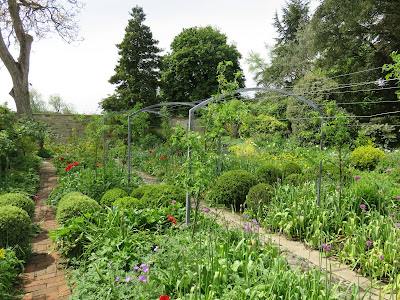Last month, while we visited Great Dixter, we got to see firsthand the process of succession planting that the late Christopher Lloyd and Head Gardener Fergus Garrett wrote about in their book titled
Succession Planting for Year-round Pleasure. Immediately after our tour, our guide Rachael Dodd, got back to work arranging pots with students on the landing of the Lutyens Steps in the Blue Garden. Meanwhile, another group of students was working on making a planting shift in the garden.
Rachael, in the blue-checked shirt, was collaborating with two students on the best arrangement of pots. They were debating/discussing the best combinations of color, and more importantly texture, in the combinations of plants. I'm sure the size and shape of the pots also contributed to the equation. Several of the gardens, most notably the House Entrance, have elaborate pot plantings. It is an excellent way to experiment with combinations of plants because the pots are easily rearranged without disturbing the plants.
In the Blue Garden, another group of students was planting out annuals and shrubs into the garden itself. A series of planks was used to protect the lawn and to prevent the soil in the garden from becoming compacted. Lessons learned in pot arranging translate well into planting a mixed border.
Yet another gardener was working in Orchard Garden while were we at Great Dixter.
The Long Border is the best example of succession planting at Great Dixter. It is a long and very deep mixed border containing trees, shrubs, perennials, biennials, bulbs and tender annuals. The bones that Edwin Lutyens created around 1910-1913 are the perfect backdrop for the vibrant and ever-changing planting scheme for which Great Dixter is known. Below is the arrangement of pots at the Front Entrance to the house that were on display when we visited last month.
For me, the best part about Great Dixter is the energy of learning and experimentation that has been palpable during every visit I have made to Great Dixter. Fergus Garrett has carried on and enhanced Christopher Lloyd's legacy for education. The Great Dixter website says it best:
"Christopher Lloyd established the garden at Great Dixter as a place where young and old gardeners would meet and share their excitement for plants. His writing in both books and the press stimulated gardeners all around the world. Students come to Dixter to learn practical skills and develop a deeper understanding of the craft of traditional flower gardening. Fergus Garrett, Christopher’s friend and head gardener, continues his legacy, both in the borders at Great Dixter and through his work with students."


































